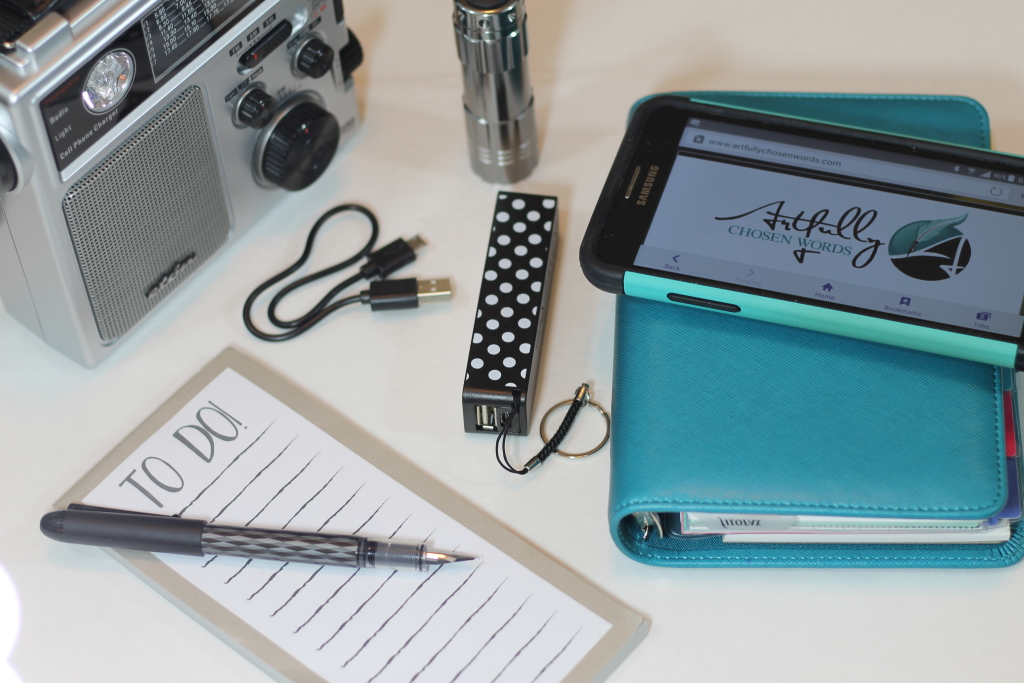
In Part I, you gained some ideas to help you have an organized plan in place for safe lighting, a way to communicate, and a source for news and emergency instructions during power outages.
In Part II, you will learn tips for heating and cooling your space during an outage, food storage and cooking.
Keeping Cool
We were in the path of the Super Derecho that left a 700 mile path of destruction at the end of June 2012. Our power was out for several days, while daytime temperatures soared in the triple-digits with stifling humidity. It was awful!
Thankfully, we had one battery powered fan. Now I have more! Keeping a moist towel handy to wipe face and arms is cooling, especially if you are lolling in front of your little fan!
I grew up in the Midwest, in a home without air conditioning. I was remembered and used some of the things my mom did to keep the house cooler in summer.
Leave the windows open in the evening and early morning to let cooler air in.
As the sun rises, close the windows, pull down the shades and close the curtains to keep the heat out, at least on the sunny side of the house.
Tip: If your windows don’t have shades, hang sheets over the window or tape aluminum foil over the glass. Shiny side out to reflect the heat!
Mom would open the basement door and run a fan at the top of the stairs to pull cooler air up into the house. You won’t be able to plug in a big fan with the power out, but leaving the basement door open may help if you can do it safely.
Is It Warm In Here?
Winter storms with heavy snows or ice can take down trees and power lines, causing power outages that last for days. Here are some things to keep in mind if you live in a region that has winter weather:
Protect your pipes from freezing. Open the cabinet doors under your sinks and letting the faucet drip will help. If you sink is on an outside wall, try adding some cardboard against the wall behind your drain pipes for a little extra insulation.
Cover your windows and close the curtains at night. Add extra insulation with foil or cardboard. You can roll up towels to use as “draft dodgers” along the bottom of windows and doors.
Caution: You need to allow fresh air into your home! Do not go overboard sealing doors and windows!
Layers are warmer. Layer your clothing and your blankets.
When you arrange bedding, add an extra layer or two with the bottom sheet, not just on top. Soft and cozy!
Fire and Heat
Please plan carefully for your alternate heat sources. Homes with children, pets and folks with breathing difficulties need special consideration.
Any kind of stove or fireplace can be dangerous if not used properly. Be sure to practice using your heat source before an emergency. Remember that in the aftermath of a severe winter storm, emergency responders may not be able to get to your house right away if you set your house on fire!
Be careful not to have any emergency heat source too close to curtains or carpets.
Wood burning fireplaces are pretty, but may not be your best bet in a power outage. Open flames can be dangerous, and slogging out to the woodpile in snow and ice is no fun.
If your house has a regular wood burning fireplace, make sure your flue and chimney are properly cleaned and maintained. Every year, homes are destroyed by chimney fires.
We have a gas fireplace that can be turned on and off with a battery powered remote. (One of our cats loves the fireplace and comes running when she hears the “click” of the remote to stand in front and watch the flames appear. She also complains loudly when we turn it off.)
Our gas fireplace puts out some serious heat. We put one of the battery powered fans on the mantle to help move the heat throughout the room during outages. The fireplace is fueled by an outside tank that we have filled at the end of summer.
In years past, we used a kerosene stove for heat. Modern models have safety features like an automatic shutoff if the heater is bumped or tipped over. We had a central area with flagstone flooring that was a perfect spot. Now our son uses it at his house.
In addition to our gas fireplace, we have a Mr. Heater Portable Buddy Heater that takes small propane canisters. The propane canisters can be purchased just about anywhere that sells camping supplies. It is easy to start and does not take up much storage space.
With any type of heat source make sure your room has sufficient ventilation. We always crack a window when running our fireplace or heater.
Now You’re Cooking
Since my stove and oven are electric, my favorite method of cooking during a power outage is using my portable butane stove burner. It is one gas-type burner powered by a butane canister. The canister is about the size of a can of hairspray. It is safe for indoor use, and easy-peazy to set up and use.
I can use any pot or skillet that I would use on my regular stove’s mid-sized burner. I would not want to use a full pot bigger that about five quarts, due to the weight. I like my little burner too much to risk breaking it!
Another indoor-safe and very inexpensive option is to use canned Sterno. It will not work for actual cooking, but is perfect to heat water for cocoa or to warm up things like canned soups. A folding Sterno stove will coast around six dollars. When I use my Sterno stove, I put it on an old cookie sheet to protect my counter top.
Summer or winter, this girl has to have her morning coffee!
Not that I’m a coffee snob, but instant does not appeal to me. I love my Farberware Yosemite Stainless Steel Percolator that I bought in 2009. The only modification is that I replaced the plastic percolator top with a glass one.
I use my percolator every time we have a power outage. Using the butane burner, I can brew a full pot of coffee in around 15 minutes. It smells heavenly while percolating! Since my electric coffeemaker has a thermal carafe, I just pour the very hot percolated coffee into the carafe and we are good to go.
Feed Me!
I always keep blocks of ice in my freezers. For my chest freezer I partially fill clean 2-liter bottles with water and freeze those for ice blocks.
In my refrigerator’s freezer compartment I keep some of those blue freezer packs for lunch boxes, and fill extra space with smaller plastic water bottles. Leave space in the water bottles to allow for expansion.
A full freezer runs more efficiently and saves energy, and in a power outage the extra ice will help keep everything cold.
Put blankets over your chest freezer and keep it closed to keep foods frozen longer.
Put ice blocks in a cooler with your milk, juice, sandwich fixings and other things you frequently take from the refrigerator. Keeping the fridge door closed will help keep the inside cold longer.
Keep a supply of shelf-stable foods that can be prepared with little or no cooking. Peanut butter, canned ravioli, soups and stews are easy and comforting.
I always have a stash of disposable cups, bowls, plates and plastic forks and spoons along with an extra box of trash bags. The last thing I want to do in a power outage is heat water for washing a load of dishes.
Water
Speaking of water, FEMA recommends keeping at least a three day supply of drinking water for each person in your home. Figure on at least one gallon per person, per day. Nursing mothers will need more. Remember to store clean water for your pets, too.
Even if you have municipal water, it could become contaminated and unsafe to drink. Water treatment plants can be interrupted by emergencies, or the main water source could be affected.
We have a well, so if there is a power outage the well pump won’t work. We always keep a generous supply of drinking water stored.
When we know a bad storm is coming, we fill up the bathtub. Buckets of water poured into the tank will let us continue to use our toilet!
The tips will help you look and some main areas to consider when you are planning and organizing for power outages. Advance planning will help you be more comfortable during power outages.
Share your ideas and questions about planning for power outages in the comment section below. Are there specific areas that you would like to learn more about?
Until then, I send you kind thoughts, from my home to yours!
